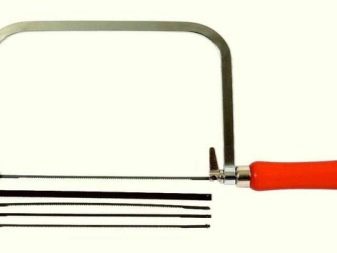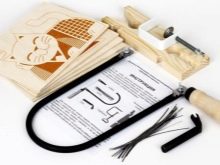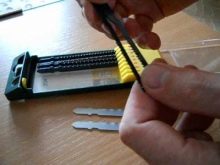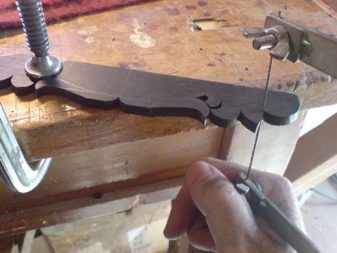Manual jigsaws: features and subtleties of operation

A hand jigsaw is used to cut all kinds of figures from wood, plastic, thin metal and plywood. It is used by both experienced professionals to create art objects and children who are just taking their first steps in making toys and interior items with their own hands.
Description and device
A manual jigsaw, from a technical point of view, is a very simple device. It consists of a metal arc, between the tips of which a sawing tool is attached. A handle is attached to one of the ends of this arc - the master holds the device for it during his work. The most important element of a jigsaw is the saw blade, since its quality and sharpness determines how easy, convenient and efficient the tool will be.



Unfortunately, modern files are not at all worthy of quality, therefore experts recommend giving preference to imported ones, for example, products from Swedish manufacturers have proven themselves very well.
Many people wonder if a hand jigsaw can completely replace an electric one. The answer to this is categorical - no. Both tools have nuances of use, so in a home workshop they should complement, not mutually exclude each other. A handheld device will not be able to cut through thick wood and dense metal, but its cut comes out thinner and much more accurate than the one that is obtained when working with an electrical modification.
It should be noted that a manual jigsaw is much cheaper than an electric one, so it is recommended to purchase it for children and adolescents who are just hone their sawing skills.


Views
Hand jigsaws are very diverse: large and small, children's, school and professional. There are models designed for cutting tiles, as well as jewelry options. They all differ in size, as well as in the features of the files. There are quite a few manufacturers of jigsaws these days, because the tools differ greatly in prices, equipment and, of course, quality. The saw blades come in a variety of sizes and structures.
The most common files are with straight double teeth, as well as spiral files.


The first option is optimal for creating a fast and straight cut. In most models, the length of such blades is 13 cm, and the working surface is 8.5 cm. These devices can be used to cut wood, plywood, and plastic. Spiral blades, unlike straightened ones, are characterized by a twisted shape, therefore they are often used to create round elements - due to their peculiar shape, the file will not get stuck in a wooden blank.
When making decorative sawing, special tools are requiredthat allow you to create smooth lines and curves, even microscopic sizes. For such manipulations, it is best to use a jewelry hand jigsaw - unlike the more common analogue used when working with wood and other sheet materials, this device is lighter and more compact.

How to choose?
In order to choose the right hand-type jigsaw, you need to pay attention to several factors, important for the features of the operation of the tool.
- The form. It can be rectangular and pointed - each of them is used for certain types of sawing.
- Tool weight. Working with a hand tool is usually quite painstaking and lengthy, so the hand gets tired very quickly. That is why it is worth giving preference to lightweight models with ergonomic handles. It is optimal if the shape of the handle is anatomical - that is, corresponding to the curves of the human palm (it is much more convenient to use them).
Keep in mind that in most cases lightweight models are produced abroad, domestic manufacturers are increasingly offering tools that have a very solid weight.



- Jigsaw frames are available in aluminum, iron, titanium or steel. If you need a durable and sturdy tool, then it makes no sense to opt for jigsaws with an aluminum frame, since the strength of this metal is not high. It is better to give preference to titanium or steel options. They are, of course, an order of magnitude more expensive, but they are able to cope with heavy loads, last much longer, and the work process itself is much more comfortable.
- Tool clamps can be represented by nuts or drums. The second option is considered more preferable, since it provides the most comfortable work with such a jigsaw - in this case, no additional devices are required, for example, wrenches to replace the blade. All you have to do is simply unscrew the drum and then replace the blade by hand.
- Manufacturing company. Chinese tools are cheap, but not worth buying because they tend to have a very short lifespan. Professionals recommend working with the products of the world famous brands Stanley and Intertool, Mastertool, and Topex. These companies have long and firmly established themselves in the market as manufacturers of the highest quality reliable sets of locksmith tools.


How to assemble?
After you have selected the material and drawn the outline of the pattern, you need to assemble the working tool. This is not difficult to do. To begin with, you need to tighten the file near the handle at the bottom, then carefully thread the free end into a special groove on the opposite side and, pressing the handle a little, fix it in it. Keep in mind that the teeth of the saw surface must also point downwards, towards the handle of your tool.
Many inexperienced users try to squeeze the frame as much as possible - this should not be done: the only thing that you will achieve in this way is to break the metal arc. It is quite enough just to bring the ends closer to each other by 1-1.5 cm. Usually the handle is squeezed by hands or rests against the chest with the tool. If you do not have the strength to tighten the drums by hand, you can resort to using pliers.


It is very easy to make sure that the saw blade is secured correctly - in this case, during cutting, you can hear high-pitched sounds made by teeth screwed into wood or plastic.
Keep in mind that thin files often break - if you plan to use the tool regularly, you will have to collect it quite often. That is why it is better to learn how to assemble before starting work, because the faster and easier it is to change the saw blade, the easier the whole work will be.


Work rules
The manual jigsaw has a fundamental difference from the usual hacksaw: the saw cuts at the moment when the master pushes it away from him, and the jigsaw, on the contrary, makes the cut when the tool moves towards the worker. This is because the working teeth point towards the handle, not away from it.
So, the procedure for working with a hand jigsaw is as follows.
- First you need to make a blank. If you have already decided on the drawing, then you can safely transfer it to the work surface - usually copy paper is used for this.It is applied to the workpiece, the required pattern is placed on top and, using a sharp pencil, is transferred to wood or plywood.
- After that, the workpiece must be well fixed - for this purpose, a special stand is attached to the workbench or any other table with a clamp. The workpiece is placed directly on the stand and the main process is started - sawing. Cutting technology has its own characteristics. Professionals advise cutting in a seated position, with the jigsaw handle at the bottom. The worker moves his hands up and down, while trying to keep the saw exactly vertical, otherwise the workpiece can simply be damaged. In those areas where the contour is curved, it is advisable to rotate the workpiece itself, but not the jigsaw, otherwise you can break the canvas. If you need to make a sharp corner, then you need to stay in one place until the saw blade unfolds, and then continue working.
Sometimes it becomes necessary to cut a figure starting from the center of the workpiece - in this case, you will have to use a hand drill to drill a small hole inside the pattern and start cutting from it.
However, try to make it not too close to the planned contour, otherwise chipping may form on the plywood. Then the file should be pulled out of the tool, inserted exactly into the hole, then - again fix it on the tool and continue your work.



- Sawed parts should be processed to smoothness - usually sandpaper and files are used for this. If necessary, the surface is coated with varnish or paint - in this case, the finished product will look more stylish, and most importantly, it will last more than one year.



Safety engineering
Despite the simplicity and seeming harmlessness of the sawing mechanism, a hand jigsaw often causes quite unpleasant injuries. However, only if the basic requirements of the safety instructions were not followed during work.
- First of all, you should make sure that the handle is fixed as tightly as possible and does not wobble. This is very important, because if during work it suddenly pops out from the attachment point, then the brush will continue to move by inertia and will inevitably bump into a metal pin, which often leads to rather serious cuts, often even to the bone.
- If in your work you use a special table called "swallow's nest", be sure to make sure that it is firmly fixed on the workbench.
- Do not lower your head too close to the work surface while cutting - the minimum distance between your eyes and the jigsaw is 40 cm.
- The file should be secured as tightly as possible in the fixing points.
These are simple rules, but following them will keep your palms and eyes intact, and will also make working with the jigsaw much more comfortable.


In the next video, you will find an overview of a convenient device for clamping files into a hand-held jigsaw.













The comment was sent successfully.